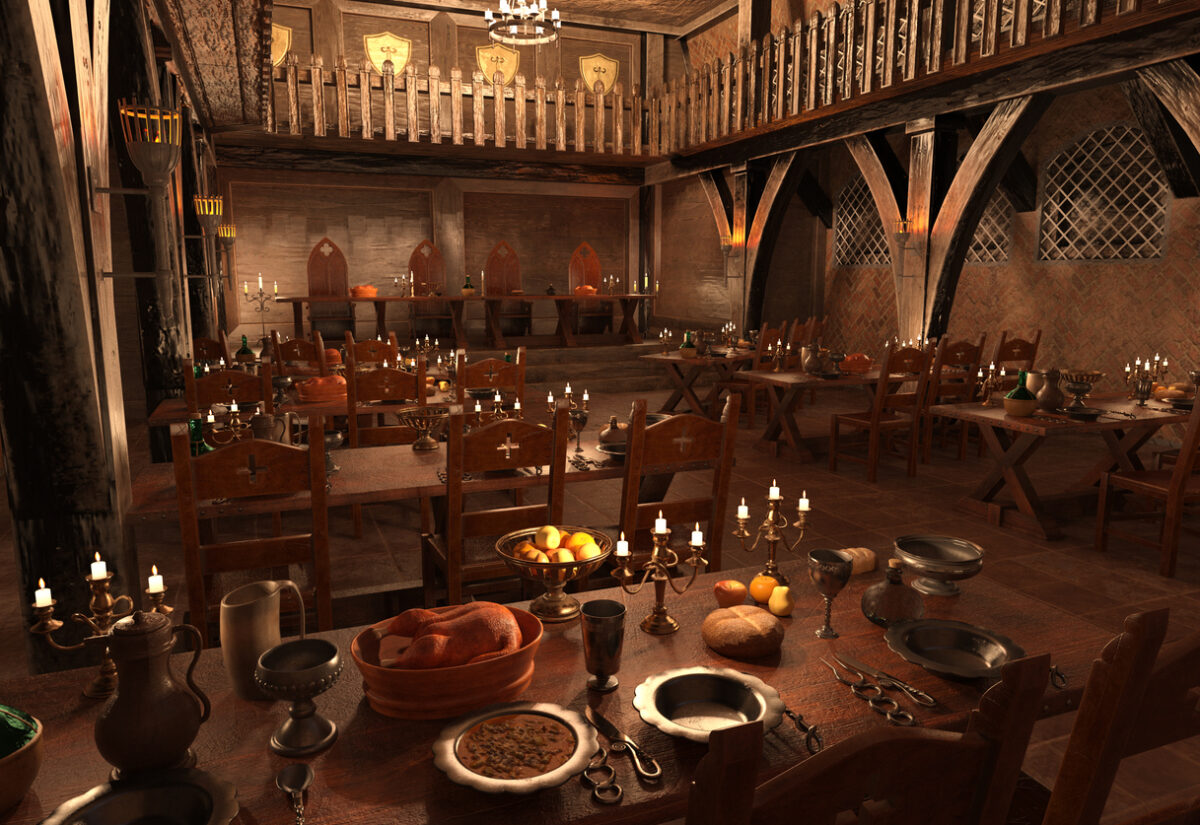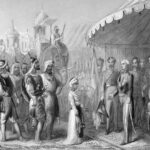Strange Medieval Feast Dishes Designed Just To Impress Guests
- Gail Stewart
- May 20, 2025
 Getty Images/iStockphoto
Getty Images/iStockphotoMedieval banquets weren’t just about feeding people—they were full-on performances. Lords and royalty used food as a tool of power, status, and spectacle. The stranger, more elaborate, or more visually astonishing the dish, the more it cemented your position as someone with wealth, creativity, and reach. Impressing guests went beyond flavour; it was about showmanship, shock, and sometimes sheer absurdity. Here are some of the most outrageous and theatrical dishes to grace the long tables of medieval great halls—meals designed not to be eaten in silence, but to start conversations, turn heads, and leave guests wide-eyed.
Cockentrice
Few medieval inventions scream spectacle quite like the cockentrice. This culinary chimera was made by taking the front half of a piglet and sewing it onto the back half of a capon (a castrated rooster). Alternatively, the reverse might be done, creating an unholy fusion of farmyard animals. The seams were hidden with herbs, pastry, or even coloured sauces to disguise the surgery.
The entire creation was then roasted on a spit, often basted with wine or sweet glazes. It wasn’t about flavour. In truth, it was pure theatre. Cockentrice was the medieval equivalent of edible sculpture, designed to surprise and impress. Guests would marvel at the unnatural union, and for hosts, it was a flex of their kitchen’s skills and their ability to do what others couldn’t.
Roast swan
Swan was never common fare; it was reserved for the elite. You needed special permission from the Crown to serve it, making it as much a political statement as a culinary one. The meat itself was greasy and tough, but that was beside the point.
To wow the room, cooks would roast the swan, then re-dress it in its own feathers to serve. Sometimes, its beak and feet were gilded, and it might even be posed with a crown or sceptre. The goal was to create the illusion that the swan had glided straight off a royal pond and onto the table, majestic and motionless. The actual eating was secondary.
Peacock pie
Peacocks were another bird chosen more for beauty than taste. Their dazzling feathers made them an ideal centrepiece for lavish feasts. The bird would be plucked, roasted, and then re-dressed with its full train of tail feathers, often dyed or decorated further. Occasionally, the peacock would be mounted on a pastry base or pie lid to appear as though it had landed mid-table.
In some cases, cooks added fireworks or flammable spirits to set the bird aflame (briefly and safely), adding even more drama. The combination of colour, feathers, gold, and fire made peacock pie less of a course and more of a production.
Leech pudding (despite the name, not grim)
The unfortunate name comes from the Old English word for a physician, or from the leaching process used to make these set puddings, rather than any actual bloodsuckers. Leech puddings were typically made from milk, sugar, ground almonds, rosewater, and occasionally rice flour. The mix was poured into moulds and left to set.
What made them a standout at feasts was their presentation. Moulds were elaborate—castles, heraldic animals, or family crests—and the puddings would be coloured with natural dyes like saffron or beetroot to heighten the effect. Think edible sculpture meets medieval jelly.
Illusion foods (fish shaped like pork, eggs made from almond paste)
On fasting days and during Lent, meat and dairy were off the table. However, the well-heeled didn’t just abstain—they got creative. Chefs used almond paste, fish, and other permitted ingredients to craft dishes that looked like forbidden treats.
Fish might be shaped and coloured to resemble roast pork, or almond paste formed into egg shells filled with yolk-tinted sweets. These illusion foods showed off a cook’s talent while poking fun at religious restrictions. They were cheeky, technical, and eye-catching.
Hedgehog stew (but not really)
The name conjures images of real hedgehogs bubbling away, but what guests usually got was a carefully shaped meatball mixture made to look like a hedgehog. Almonds, cloves, or even pastry shards were inserted to create the illusion of spines.
These dishes played on novelty and charm. Diners got the pleasure of something cute, strange, or thematic, while the cooks got to flex their skills. It was edible whimsy, and it gave people something to talk about between courses.
Gilded roast boar
A roast boar’s head was already a medieval showstopper, with its curled tusks and fierce glare. But elite households took it further by coating parts of it—often the ears, snout, or tusks—in gold leaf. Sometimes the eyes were replaced with polished stones or berries to increase the realism (and the drama).
Stuffing the boar’s mouth with apples or citrus fruit was common, but some versions had the head open to reveal a smaller roast bird or fruit arrangement inside. Gilded boars weren’t just meat. They were centrepieces of culinary theatre.
Jelly castles and edible architecture
Jelly, or “gele,” wasn’t just for dessert. It was a medium for edible engineering. Cooks boiled bones and skins to make a stiff, clear gel, which they coloured with herbs, flowers, or spices. They’d pour the mixture into intricately carved moulds, stacking layers to build towers, bridges, or animals.
At one recorded feast, a jelly castle reportedly contained tiny moving parts, with drawbridges and sugar knights. Another time, a jelly fortress collapsed mid-presentation, causing laughter and applause in equal measure. These creations were fragile, stunning, and proof of the kitchen’s ambition.
Stuffed and reassembled animals
Beyond cockentrice, many animals were gutted, cooked, stuffed, and then sewn back together to appear whole. A piglet might be filled with birds and bread stuffing, sewn back into shape, and roasted until it looked perfectly lifelike.
Sometimes, the animal was posed as if alive, propped up with sticks, eyes glazed with honey, or hooves polished. In more extreme cases, mechanisms were installed to make the animals appear to move. It was about illusion, mastery, and the ultimate surprise.
Coloured food and edible metal
Colour wasn’t just decorative; it was a statement. Saffron turned dishes bright yellow, beetroot brought a vivid red, and parsley or spinach gave greens. Foods might be painted, layered, or served in rainbows. Some dishes were dyed deliberately to confuse the eye or imply ingredients they didn’t contain.
Gold and silver leaf were added not for taste, but for prestige. Gilded pies, gold-dusted puddings, and silver-speckled sauces showed the host had access to wealth, spices, and artisanship. It was food as flex.
Musical pies with live birds
The most outrageous stunt involved placing live birds inside hollowed-out pastry shells. The pie was brought to the table closed and decorated, then sliced open—at which point the birds (usually small songbirds) would fly out.
The idea was spectacle, not cruelty (though the ethics would raise eyebrows today). Inspired by this tradition, the nursery rhyme “Sing a Song of Sixpence” references “four and twenty blackbirds baked in a pie.” These dishes weren’t for eating—they were entertainment with wings.
Marchpane centrepieces
Marchpane, a predecessor to marzipan, was a mix of ground almonds and sugar that could be moulded into anything. Castles, animals, coats of arms, religious scenes—you name it. It was sweet, malleable, and perfect for spectacle.
At high-status feasts, entire tablescapes were made from marchpane, decorated with edible paint and gold. Guests might be invited to break off pieces as the meal progressed. It was a mix of sculpture and sugar, and often served as the climax to the evening.
Medieval feasts were a spectacle
Medieval feasts were about more than just feeding people—they were immersive, theatrical events designed to dazzle and intimidate. These dishes weren’t just food; they were statements. They told stories of power, piety, wealth, and whimsy. Whether through illusion, scale, or pure absurdity, hosts used their tables to broadcast status and ingenuity.
While many of these dishes wouldn’t win flavour awards today, they remind us that food has always been about more than nourishment. It’s performance, it’s identity, and sometimes, it’s downright bizarre.



